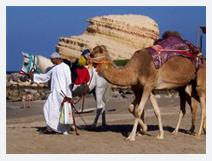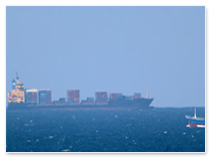About Oman
Overview
Travel to a place so beautiful and majestic that could captivate your greatest imagination. Discover the breathtaking natural beauty of Oman along with its fascinating culture and warm-friendly people. Explore miles of undisturbed coastline. The shimmering emerald ocean hold a wealth of marine life and extraordinary treasures of the reefs. Climb the highest peak and experience the thrill of conquering the incredible heights.
Geography
The third largest country in the Arabian Peninsula, the Sultanate of Oman covers 309,500 km2 and has a coastline of 1,700 km.It is bounded by the Republic of Yemen on the southwest, the Kingdom of Saudi Arabia on the west and the United Arab Emirates on the north and the Arabian Sea on the east. Oman is one of the most diverse countries of the Peninsula.
Oman's coastline borders the Sea of Oman and the Arabian Sea. The strategically important Strait of Hormuz is the only stretch of water between the Arabian Gulf and the Indian Ocean and is, therefore, a vital route for the transportation of crude oil, gas and cargo.
Oman is enjoying this unique and strategic location on international maritime routes outside the straight of Hormuz. Providing Fast and easy access to emerging markets in the Middle East, Asia, Africa, even Europe through Yemen and the Suez Canal. This explains why Oman was used as a hub in the Silk Routes back in history.
People
Omanis are regarded as gentle, peace-loving and warm people. They have impressed visitors of their charm and good manners with their English communication ability. Men wear the traditional disdasha, which is an ankle-length, collarless gown with long sleeves and a tassel (furakha) sewn at the neckline that distinguishes Omani from other Arab residents. Their head dress is the musar and on official occasions they wear the khanjar, a symbol of male elegance, around their waist. Omani women`s dress, richly colored and worn with gold or silver jewelry, also varies in style from region to region. The main components of a woman`s outfit comprise of a dress which is worn over trousers (sirwal) and the headdress, called the lihaf. Many women in Oman paint their hands and feet with henna, particularly before special occasions such as Eid holidays or weddings.
The Economy
Since the accession of His Majesty Sultan Qaboos bin Said to the throne in 1970, Oman had experienced dramatic strength on its economy. It had established strong diplomatic relationships with Arab and other countries and became prosperous and stable. With the discovery of oil reserves, major developments have been attained including modern infrastructure of buildings, ports and airports, multi-lane roads, prestigious schools and universities, advanced healthcare services.
Infrastructure
Oman is very well established country in terms of infrastructure. Oman is full connected with roads networks that are built according to the highest international standards. There are four major seaports (Sultan Qaboos in Muscat, Sohar, Salalah, and Duqm) that are connecting Oman to the world with direct international lines; and there are plans to build more seaports. There are two international airports in Muscat and Salalah which are currently being upgraded, also the government is building three new airports in Sohar, Sur, and Duqm. The railway project will be connecting the full country, and also connecting Oman to the other Arabian Gulf Countries.
Climate
Climate in Oman is diverse varies from region to region. Temperature differed between humid coastal areas and hot dry desert interior especially during different seasons from summer to winter. During summer season, temperature can soar to 50 degree Celsius in the northern region, making Dhofar province, in the southern part, a perfect place to stay with 18-23 degree Celsius when monsoon season falls between June to September. Most visitors prefer to visit the country during the winter or cold season that comes from the middle of October through the end of March with temperature of 14-24 degree Celsius.
Religion
Islam is the religion of the Omanis. This is evident with great number of masjids (mosques) in varied elegance installed throughout the place. With the consideration and being friendly to other people, Oman allows other religions to be practiced in churches and temples.
Currency
The national currency in Oman is called Omani Rial. The Omani currency has a fixed exchange rate with the US Dollar. OMR 1 = USD$ 2.60.













